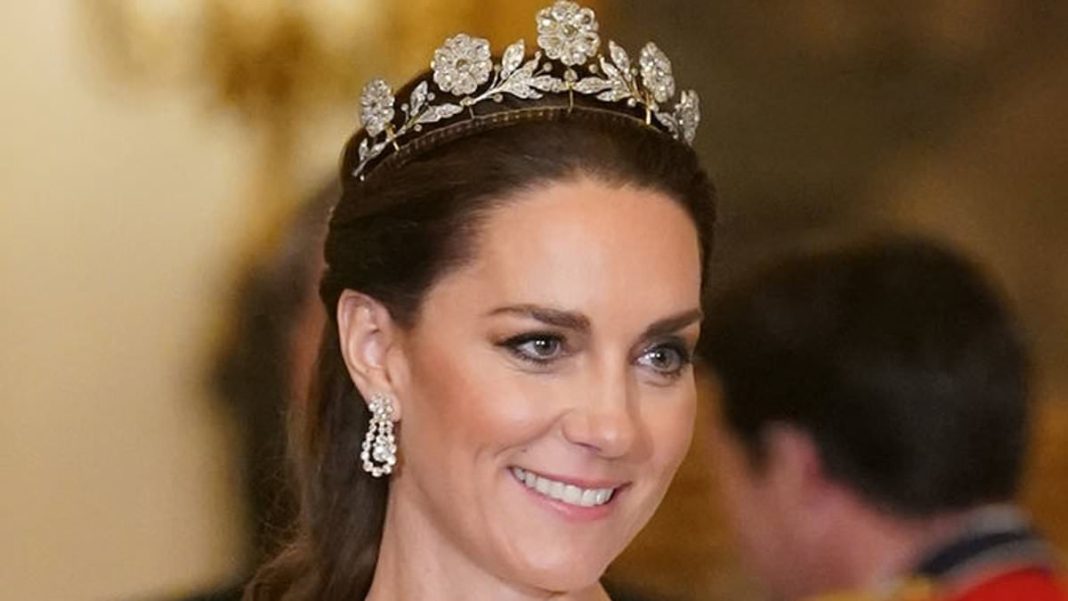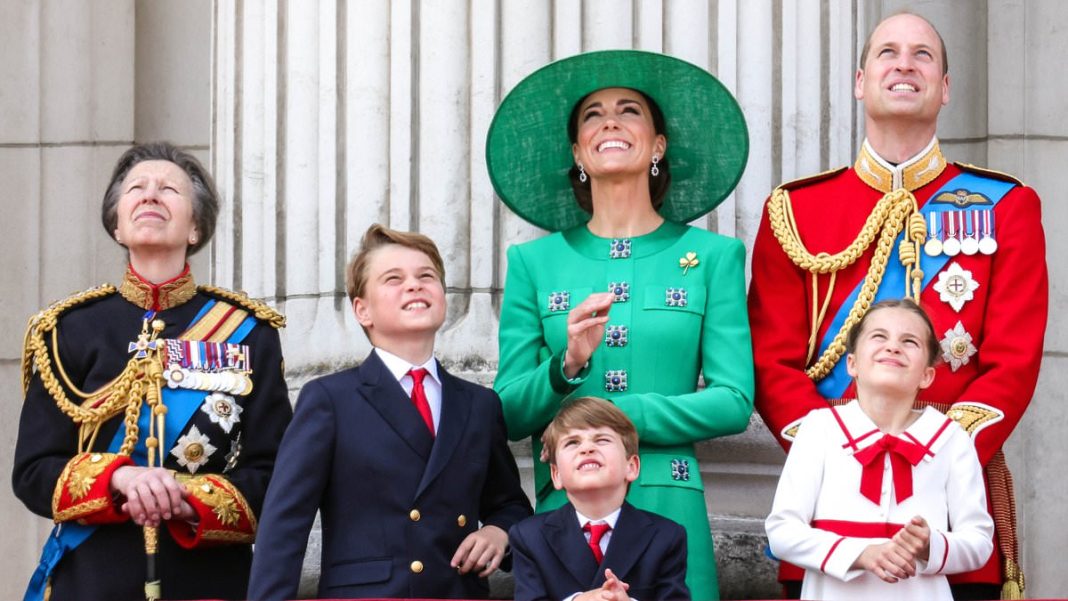The triumph of the Tiara and how Kate broke with tradition,
When the date of the Coronation of King Charles III was announced in October two years ago, there was a sigh from jewellery lovers across the world. The prospect of a sea of sparkling tiaras, last seen at the late Queen’s coronation seventy years previously, would raise the nation’s spirits.
Bets were made on about which tiara the newly minted Princess of Wales might wear: would she choose her favourite, Cambridge Lover’s Knot? Or go for something even more regal and rare?
Would Princess Beatrice wear her great great grandmother, Queen Mary’s 1919 Fringe Tiara that she wore for her wedding in July 2020, worn by her grandmother at her wedding in 1947? Would her sister, Eugenie, wear her bridal Greville Emerald Kokoshnik Tiara.
What would the Princess Royal wear to the Coronation of her brother? After all, her aunt wore the Cartier Halo Tiara to her sister’s 1953 enthroning – which Kate famously wore in the Abbey in 2011. And the Royal Duchesses of Edinburgh, Gloucester, Kent and so forth? We haven’t even touched on the foreign Royals; – in 1953, Princess Märtha of Sweden wore Empress Joséphine’s Emerald Tiara – would Crown Princess Victoria follow suit? And Princess Mary? Her spectacular Danish Ruby Tiara, that looks like a gorgeous garland of flowers?
Of course, in the end it was a collective ‘Oooh’, almost louder than the rain on Westminster’s Abbey roof. Kate wore, an albeit beautiful, costume jewellery floral headpiece alongside Princess Charlotte – and the rest of the guests were in hats or fascinators. Of course there were some spectacular jewels.
The King was carefully considerate in the Dress Code for his Coronation – after all, very few of the previous peers and peeresses were invited – many of whom no longer have the ‘family fender’ (as my ancestor the 6th Marchioness of Londonderry called it – see below); they have either have sold them (you can still buy the exquisite Anglesey Tiara from Hancock’s on St James’s Street, London) or had them broken up and made into jewellery more wearable today. Some, such as the Portland Tiara, have been stolen. State Banquets still ring for diamond diadems, and Kate delighted us all when in November 2023 she wore the Queen Mother’s Strathmore Tiara for the visit of the President of South Korea – and the national papers – who put the tiara, unseen for over a century, firmly on the front page.
Tiaras hark from a bygone world – a world that so many Royals have covered in dust sheets
Let’s look at their history to understand why, in the 21st century, they still have the power to impress.
Napoleon Bonaparte might have been Europe’s enemy number one at the turn of the 19th Century, but he did succeed in reintroducing the bejewelled head ornament, which became de rigeur throughout the continent.
Until he decided to dress up his family – and particularly his wife, later Empress, Josephine – in diamond diadems, these exquisite head ornaments had been almost non-existent since Ancient Greece and Rome. Napoleon wanted to revive the pomp and ceremony of the Ancient World – to which he looked for inspiration; in emblems, iconography and his family’s fashions. in Napoleon’s eye, with no crown jewels, tiaras transformed the Bonapartes into bona fide royals.
It’s important to note that despite Le Petit Corporal taking the credit for tiaras, there are sketches of a young Queen Charlotte wearing diamonds set in diadems during the 1760s. And the spectacular Spencer Tiara, famously worn by Lady Diana Spencer during her 1981 wedding, was in fact created in 1767 for an ancestor, Viscountess Montagu. The tiara’s undulating diamond set scroll work, meeting in the middle as a heart, was replicated in the early twentieth century when, in the 1930s, Garrard reset some of the diamonds.
It is Queen Charlotte’s granddaughter, and namesake, Princess Charlotte, who is to thank for the tradition of adding a tiara to the bridal trousseau – up until then, it was strictly married women who wore them. For Princess Charlotte of Wales’s marriage in 1816, she wore a tiara set with brilliant diamonds to secure her veil. And at the coronation of her father George IV, for whom the inimitable Diamond Diadem was created for the occasion, ‘coronets, tiaras, circlets, aigrettes’ were worn throughout the Abbey. Quickly the British Court cottoned on and the tiara became a status symbol, an investment and part of a ‘uniform’, that married women of the aristocracy were expected to wear to formal occasions, from generation to generation.
Tiaras during the reign of Queen Victoria were substantial sparklers. The young monarch turned her aunt Queen Adelaide’s diamond fringe necklace into a tiara.
When my paternal grandmother’s ancestor, Theresa, married the 6th Marquess of Londonderry, she inherited some spectacular pieces – and called them ‘the family fenders’. Many of the Londonderry Jewels are now on permanent loan to the V&A, and are perfect examples of their formidability.
The Londonderry Tiara was commissioned in 1854 from Garrard and set with existing diamonds belonging to the family, including those taken from a belt worn to the Coronation of George IV.
In the 1880s my ancestor Theresa (née Chetwynd-Talbot – daughter of the 19th Earl of Shrewsbury), a formidable hostess, was photographed in a series where she is wearing the tiara – she also wore it as part of her costume at the Devonshire House Ball in 1897. At the Coronation of Edward VII she wore this tiara with enormous baroque pearls attached to the top (it is said that she wanted to stand higher than Queen Alexandra). It became so top heavy that when she needed to visit the loo in the Abbey, the half-a-century-old tiara toppled off her imposing head into the loo. She wasn’t called a ‘highwaywoman in a tiara’ for nothing.
Helen Molesworth, jewellery curator of the V&A whose book PRECIOUS was published in the summer, says: ‘They form a fascinating record of jewellery history. From the stately crown-like creations in heavier gold and silver settings of the nineteenth century, to the lighter platinum aigrettes and bandeaus of the early 1900s.’ The latter of which suited the dramatic haircuts of the era.
Who can forget Lady Mary Crawley appearing with a slick bob in season five of Downton, and causing such a sensation? Tiaras had to adapt to fit this new trend – and so the bandeau appeared. The Strathmore Tiara, when worn by Lady Elizabeth Bowes-Lyon, was worn low on her forehead, whereas when the Princess of Wales wore it last year, she wore it above her hairline as is traditional these days.
Will there every be an era when the tiara is out of fashion? I for one hope not!









